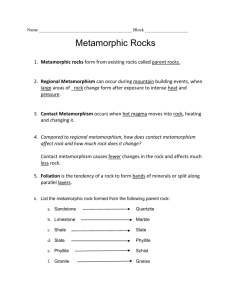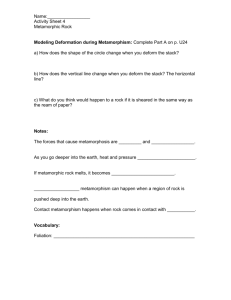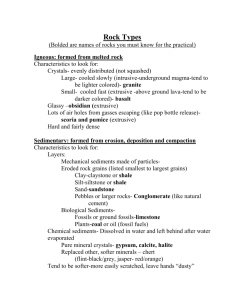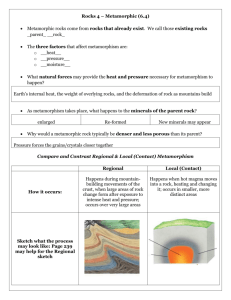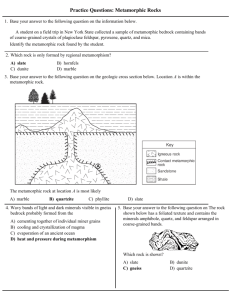Earth Revealed - Metamorphic Rocks
advertisement
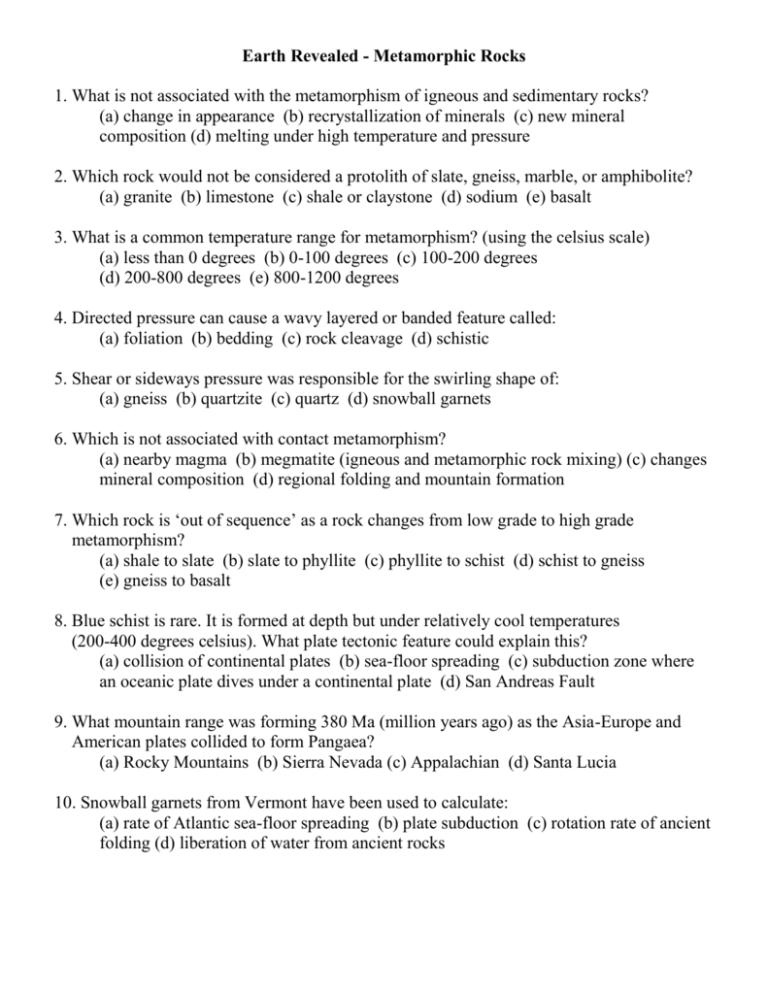
Earth Revealed - Metamorphic Rocks 1. What is not associated with the metamorphism of igneous and sedimentary rocks? (a) change in appearance (b) recrystallization of minerals (c) new mineral composition (d) melting under high temperature and pressure 2. Which rock would not be considered a protolith of slate, gneiss, marble, or amphibolite? (a) granite (b) limestone (c) shale or claystone (d) sodium (e) basalt 3. What is a common temperature range for metamorphism? (using the celsius scale) (a) less than 0 degrees (b) 0-100 degrees (c) 100-200 degrees (d) 200-800 degrees (e) 800-1200 degrees 4. Directed pressure can cause a wavy layered or banded feature called: (a) foliation (b) bedding (c) rock cleavage (d) schistic 5. Shear or sideways pressure was responsible for the swirling shape of: (a) gneiss (b) quartzite (c) quartz (d) snowball garnets 6. Which is not associated with contact metamorphism? (a) nearby magma (b) megmatite (igneous and metamorphic rock mixing) (c) changes mineral composition (d) regional folding and mountain formation 7. Which rock is ‘out of sequence’ as a rock changes from low grade to high grade metamorphism? (a) shale to slate (b) slate to phyllite (c) phyllite to schist (d) schist to gneiss (e) gneiss to basalt 8. Blue schist is rare. It is formed at depth but under relatively cool temperatures (200-400 degrees celsius). What plate tectonic feature could explain this? (a) collision of continental plates (b) sea-floor spreading (c) subduction zone where an oceanic plate dives under a continental plate (d) San Andreas Fault 9. What mountain range was forming 380 Ma (million years ago) as the Asia-Europe and American plates collided to form Pangaea? (a) Rocky Mountains (b) Sierra Nevada (c) Appalachian (d) Santa Lucia 10. Snowball garnets from Vermont have been used to calculate: (a) rate of Atlantic sea-floor spreading (b) plate subduction (c) rotation rate of ancient folding (d) liberation of water from ancient rocks Earth Revealed - Metamorphic Rocks - Answers 1. What is not associated with the metamorphism of igneous and sedimentary rocks? (d) melting under high temperature and pressure 2. Which rock would not be considered a protolith of slate, gneiss, marble, or amphibolite? (d) sodium 3. What is a common temperature range for metamorphism? (using the celsius scale) (d) 200-800 degrees 4. Directed pressure can cause a wavy layered or banded feature called: (a) foliation 5. Shear or sideways pressure was responsible for the swirling shape of: (d) snowball garnets 6. Which is not associated with contact metamorphism? (d) regional folding and mountain formation 7. Which rock is ‘out of sequence’ as a rock changes from low grade to high grade metamorphism? (e) gneiss to basalt 8. Blue schist is rare. It is formed at depth but under relatively cool temperatures (200-400 degrees celsius). What plate tectonic feature could explain this? (c) subduction zone where an oceanic plate dives under a continental plate 9. What mountain range was forming 380 Ma (million years ago) as the Asia-Europe and American plates collided to form Pangaea? (c) Appalachian 10. Snowball garnets from Vermont have been used to calculate: (c) rotation rate of ancient folding


